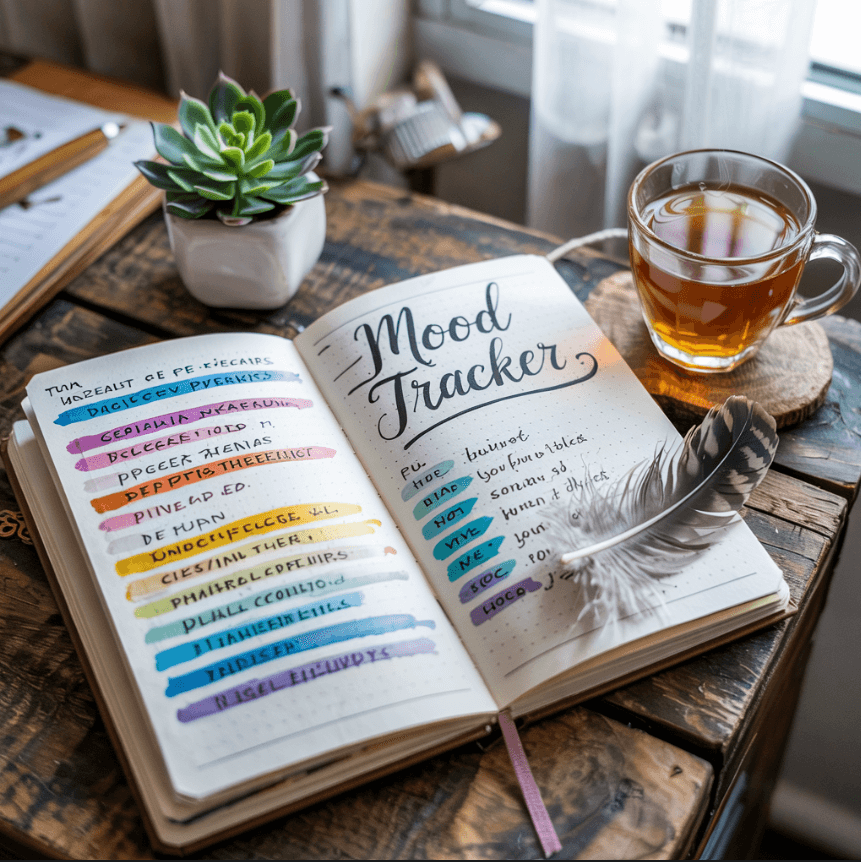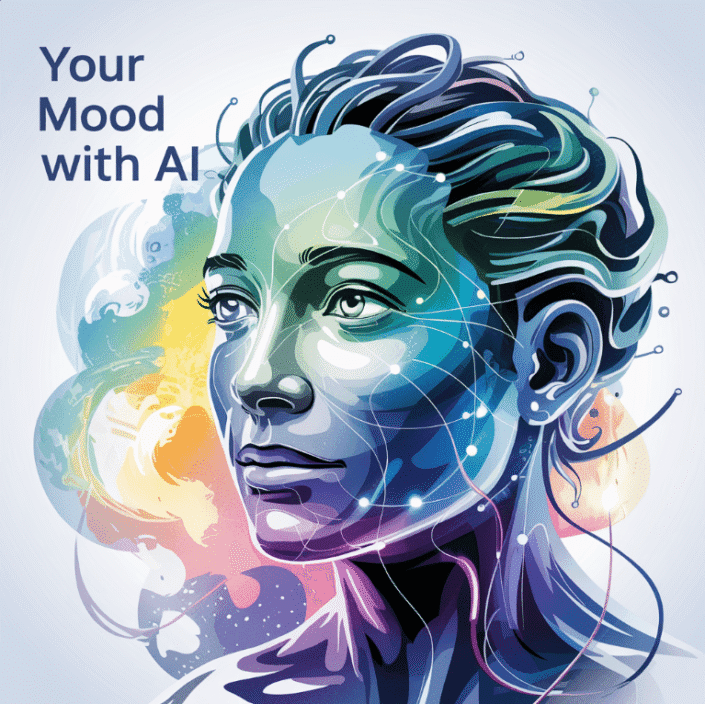In a world where our moods fluctuate more rapidly than the social media feeds in which we share them, making sense of our emotions has never been more confusing — or more critical. That’s where AI-powered mood tracking comes into play. Imagine a personal emotional assistant that you can have on the go—one that doesn’t just listen, but one that also actually knows you. From subtle shifts in tone to identifying patterns in your daily behavior, artificial intelligence is reshaping our approach to mental health and emotional well-being. Whether you’re managing stress, building emotional intelligence, or simply checking in with yourself, this cutting-edge technology is rewriting the road to self-awareness — one data point at a time.
1. What is mood tracking?
Mood tracking refers to checking your emotional state at intervals throughout the day. It’s like maintaining a feelings diary, but it’s much more methodical. In writing how you feel at various points in the day, you’ll see trends in your emotions and discover what influences your mood.
When I first began tracking my moods, it felt a little weird, to be honest. What difference could writing down my feelings make? But after a few weeks, I became more aware of my feelings and what causes them. It was eye-opening.
1.2.Why you should keep track of your emotional state
Tracking your mood can be a very useful tool. Here are some advantages I per se experienced:
- Improved self-awareness: You begin to gain insight about yourself.
- Understanding triggers — You can identify what works for you and doesn’t.
- Enhanced communication: It’s simpler for you to communicate how you’re feeling to others.
- Early sign observer: You may spot symptoms of stress or anxiety before they become all-consuming.
1.3. The old way vs. tracking with AI support
Track Your Mood/Feeling Traditional mood and emotional tracking typically require you to write down your mood in a journal or an app manually. It’s easy to do but can be time-consuming and depends a lot on your interpretation of your feelings.
AI-assisted mood tracking, on the other hand, employs artificial intelligence to assist you analyze your mood data. It can identify patterns that you may overlook and suggest advice based on big datasets. Isn’t it fascinating when AI knows what mood I’m in before even I realise it?
2. How To Start Tracking Your Mood With AI

2.1.How to choose the right AI-powered mood-tracking app
However, there were far too many of them when I was searching for an app to track how I was feeling. Some key factors to consider include
- User interface: Should it be easy to use and attractive?
- AI Functions: What type of analytical assessment does it provide?
- Privacy: What does it do with your sensitive data?
- Integration: Can it work with other health apps you already use?
Popular ones are Moodfit, Daylio, and Youper. Feel free to explore and find one that best suits you.
2.2. Profile and Preferences setup
So, once you’ve decided on an app, let’s get it up and running. Most apps will walk you through this process, but in general, you’ll:
- Create an account
- Respond yes or no to some questions about your existing mental condition
- Choose how often you want to log your mood (daily, weekly, etc.)
- Standardize the moods or feelings you wish to track
Don’t expect to do everything perfectly from day one. You can change your settings later, as you determine what works best for you.
2.3. Creating a daily tracking habit
- The key is to be consistent in mood tracking. This is what has worked for me:
- Use your app’s notification feature or set alarms on your phone.
- Tie it to habits you already have: I record my Emotional Well-being right after my morning coffee and evening tea.
- Set a frequency: Keep it simple: Once or twice a day to begin with. Feel free to crank up the frequency later if you wish.
- Be patient: It may seem awkward at first, but persevere. It becomes a habit.
3. Why AI Mood Tracking Tools Are a Game Changer

3.1. Text and voice emotion recognition
Dozens of AI-powered apps can take an analysis of the words you tend to use, or the tone of your voice, and give you a sense of your emotional state. It’s pretty amazing! I even wrote a journal entry just fine, only for the app to flag latent anxiety I hadn’t even acknowledged.
3.2. Detection of patterns and analysis of trends
That’s where AI shines. It can identify patterns in your mood over time, such as:
- Weekly cycles (e.g., lower mood on Mondays)
- Seasonal changes
- Relationships with other variables such as sleep or exercise
I discovered through my tracking that my mood dropped a bit every third Thursday – apparently, this coincides with a regular stressful meeting I have at work.
3.3.Insights that are tailored to you, plus recommendations
AI provides personalized recommendations based on your own data. This might include:
- Activities to try and improve your mood
- Nudges to take a moment for self-care
- When to seek professional help — the recommendations
It is very helpful to have these insights. They’re like a friend who always knows the right thing to say when you’re having a bad day.
Interpreting Your Mood Data
4. How to use mood charts and graphs

Made with AI: AI journaling mood tracker app
4.1. How to use mood charts and graphs
- Most apps display your mood data in a visual format. You might see:
- Graphs tracking mood over time
- Different emotions in pie charts
- Color-coded calendars
If it seems complicated at first, don’t panic. Spend a few minutes clicking through the visualizations, and see what each visualization tells you. I found it useful to stick to one chart type at a period.
4.2. Noticing triggers and patterns Identifying triggers and patterns
Identify any consistent patterns in your mood data. You might notice:
- That always has an impact on your mood in some way
- Two things you tend to feel better or worse about at different times of day
- Things that lift or lower your moods
I noticed I always feel better after being in nature, even if that means walking on the grass.
4.3. Correlating mood with external factors
Many apps allow you to track other factors alongside your mood, such as:
- Sleep quality and duration
- Physical activity
- Diet
- Medication
His can allow you to perceive how your emotions are affected by these factors. I notice, for example, a clear correlation between my mood and the amount of sleep I get.
5. Using AI Insights for Personal Growth

5.1. Goals for emotional well-being
Using the patterns from your mood tracking, you can set relevant goals. These might include:
- From increasing the frequency of positive emotion
- Reducing stress levels
- Improving emotional stability
My initial aim was just to have more ‘good’ days than ‘bad’ ones each week. It was a tiny target, but it provided me with something tangible to aim for.
5.2. Applying coping strategies suggested by AI
AI could suggest strategies based on what has worked for you and people like you. These might include:
- Mindfulness exercises
- Techniques of Cognitive Reframing
- Physical activities
I was also sceptical of meditation, but after my app kept recommending it, I tried it. I was surprised at how much it helped me to manage stress better.
5.3. Evaluation and corrections of your process
Review your goals and track your goals regularly. Be prepared to:
- Celebrate small victories
- Adjust your goals if needed
- Test new strategies if the existing ones are not working
Emotional health and well-being is a journey; not a destination. And be gentle with yourself as you go.
Combine Mood Tracking with Other Medical Apps
6. Combine Mood Tracking with Other Medical Apps

6.1.Linking to Sleep and activity trackers
Many mood-tracking apps can integrate with popular fitness trackers or smartwatches. That also gives you a view of how your physical activity and sleep patterns account for your mood.
I was surprised to see just how much my mood matched up with my sleep quality. On the days when I got good sleep, I felt better.
6.2. Syncing with nutrition and medication apps
Some apps include integration with nutrition trackers or medication reminders, too. This can help you determine how changes to your diet or medication regimen affect your emotional state.
For instance, I learned that I tend to feel worse on days when I don’t eat breakfast. It was a powerful insight.
6.3. Does this include creating a holistic health dashboard
And you can aggregate it all into a one-stop view of your health overall by linking multiple health apps. This might include:
- Mood data
- Sleep patterns
- Physical activity levels
- Nutrition information
- Medication adherence
So, having all of this information in one place can really provide insight into your health and help you make better choices.
- Mood Monitoring Technology for Wearable Devices
Wearable technology continues to grow in its ability to take mood readings. These techniques are still quite early in development, but they have huge potential for more passive and continuous monitoring of mood and affect, such as
- Heart rate variability analysis to detect stress levels
- Skin conductance measurements to gauge emotional arousal
- Voice analysis to identify emotional states
Although these technologies are still developing, they afford the possibility of more passive and continuous tracking of mood.
I tested out a smartwatch with stress detection capabilities; it wasn’t (at least not always) accurate, but it did make me more mindful of how stressed out I was during the day.
8. Protecting Privacy and Data Security

8.1.Learn about data collection and storage practices
Know how your mood-tracking app uses your data. Look for information on:
:
- What data is collected
- How it’s stored and protected
- Who has access to it
I read the privacy policy every time before I start to use an app, even when it’s a bit boring. It is worth it for peace of mind.
8.2. Managing who can share and who has access
Most apps include setting pages where you can decide what data is shared and with whom. You might be able to:
- Decide what you want to share with your healthcare provider
- Yet choose whether you write anonymized information for the study
- Limit access to your location or other device functions
Just remember, you control your data. Do not be afraid to change settings to what you are comfortable with.
8.3. Locking up your emotional health data
To protect your mood data:
- Set a unique, complex password for your mood-tracking app
- If it’s available, turn on two-factor authentication
- Look out: Sharing your mood data on social media
I have my mood tracking app locked with my fingerprint like my banking app. My financial health is just one component of my well-being!
9. Overcoming Common Challenges
9.1. Dealing with tracking fatigue
Of course, there are times when you may get tired of entering your mood. To combat this:
- Take breaks if needed
- Reduce your tracking (e.g., log less often)
- Think back to the benefits you have received
When I start to feel tracking fatigue, I look at what I’ve done so far, and that’s usually enough to keep me on the right path.
9.2. What to do with incorrect predictions from an AI?
Sometimes the AI may get it wrong. If this happens:
- Give app-based feedback if applicable
- Keep in mind that AI is a tool, not a substitute for your good judgment
- If you’re worried, talk to a healthcare provider about large differences.
There was one week when the AI kept getting my mood wrong. I ended up getting frustrated with it, but it prompted a nice chat with my therapist about some feelings I had been repressing.”
9.3. Practicing mindfulness around technology usage
Though mood-tracking apps may aid in self-exploration, don’t get too attached to trends — both technological and otherwise. Try to:
- Try getting in touch with your feelings without immediately grabbing your phone
- Allot specific times every day for no tech.
- Be more independently mindful by using insights from the app.
After a few months of making logging a daily repetition, I had gotten into a much better groove of being able to feel and name my emotions without needing to log them in the app.
AI-Driven Mood Tracking is an incredibly valuable tool for gaining insights into and improving your mental health. Logging your moods regularly, using AI insights and integrating with other health data you have access to, gives you meaningful insights into what your mood is like and what affects it. Tap into the lingo, account for the privacy issues, cope with everyone’s well-known stubbornness — and use the technology to ADD to, not REPLACE your inner knowledge. Mood tracking can, with time and practice, be a powerful tool in your mental health toolkit.
Frequently Asked Questions (FAQs)
1.How frequently must I record my mood?
Once or twice a day to begin with and then feel your way into what works for you.
2.Can AI truly sympathize with my feelings?
Sure, AI identify patterns and makes inferences but is it infallible? Never forget to listen to your own heart.
3.Is my mood data secure?
Read the privacy policy of your app of choice. Most credible apps employ robust encryption for your data.
4.What if I don’t log my mood?
Don’t worry! All you needed to do was pick up where you left off. So good for consistency, but you don’t need to be perfect.
5.What if you could track your mood with the miracle of modern technology?
No, mood tracking is a useful tool, but it is not a replacement for professional mental health care if you need it.

